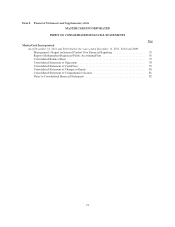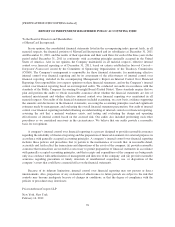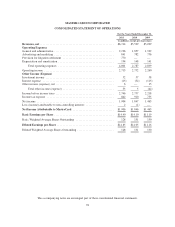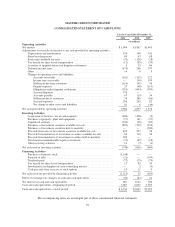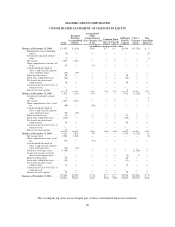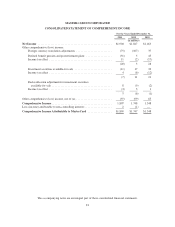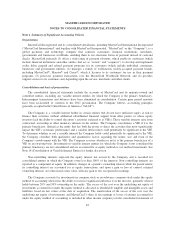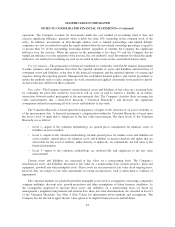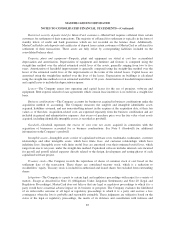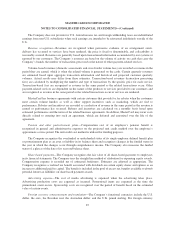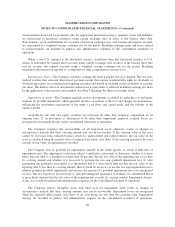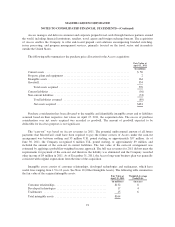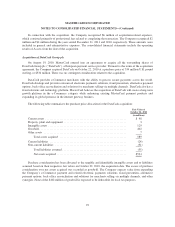MasterCard 2011 Annual Report Download - page 88
Download and view the complete annual report
Please find page 88 of the 2011 MasterCard annual report below. You can navigate through the pages in the report by either clicking on the pages listed below, or by using the keyword search tool below to find specific information within the annual report.MASTERCARD INCORPORATED
NOTES TO CONSOLIDATED FINANCIAL STATEMENTS—(Continued)
Cash and cash equivalents—Cash and cash equivalents include certain investments with daily liquidity or
with a maturity of three months or less from the date of purchase. Cash equivalents are recorded at cost, which
approximates fair value.
Restricted Cash—The Company classifies cash as restricted when the cash is unavailable for withdrawal or
usage. Restrictions may include legally restricted deposits, contracts entered into with others, or the Company’s
statements of intention with regard to particular deposits.
Investment securities—The Company classifies investments in debt securities as held-to-maturity or
available-for-sale and classifies investments in equity securities as available-for-sale or trading.
Available-for-sale securities that are available to meet the Company’s current operational needs are classified as
current assets. Available-for-sale securities that are not available to meet the Company’s current operational
needs are classified as non-current assets.
Investments in debt securities are classified as held-to-maturity when the Company has the intent and ability
to hold the debt securities to maturity and are stated at amortized cost. Investments in debt securities not
classified as held-to-maturity are classified as available-for-sale and are carried at fair value, with unrealized
gains and losses, net of applicable taxes, recorded as a separate component of other comprehensive income (loss)
on the consolidated statement of comprehensive income (loss). Net realized gains and losses on debt securities
are recognized in investment income on the consolidated statement of operations.
The fair values of the Company’s short-term bond funds are based on quoted prices for identical
investments in active markets and are therefore included in Level 1 of the Valuation Hierarchy. The fair values of
the Company’s available-for-sale municipal securities, U.S. Government and Agency securities, corporate
securities, asset-backed securities and other fixed income securities are based on quoted prices for similar assets
in active markets and are therefore included in Level 2 of the Valuation Hierarchy. The fair value determination
for the Company’s Auction Rate Securities (“ARS”) is based primarily on an income approach and is therefore
included in Level 3 of the Valuation Hierarchy. See Note 5 (Fair Value) and Note 6 (Investment Securities) for
additional disclosures related to the fair value standard.
The Company has incorporated the considerations of guidance pertaining to determining the fair value of
financial assets in inactive markets in its assessment of the fair value of its ARS as of December 31, 2011 and
2010. The guidance provides consideration of how management’s internal cash flow and discount rate
assumptions should be considered when measuring fair value when relevant observable data does not exist, how
observable market information in a market that is not active should be considered when measuring fair value and
how the use of market quotes should be considered when assessing the relevance of observable and unobservable
data available to measure fair value. See Note 5 (Fair Value) for further detail.
Investments in equity securities classified as available-for-sale are carried at fair value, with unrealized
gains and losses, net of applicable taxes, recorded as a separate component of other comprehensive income (loss)
on the consolidated statement of comprehensive income (loss). Net realized gains and losses on available-for-sale
equity securities are recognized in investment income on the consolidated statement of operations. The specific
identification method is used to determine realized gains and losses.
Settlement due from/due to customers—The Company operates systems for clearing and settling payment
transactions among MasterCard customers. Net settlements are generally cleared daily among customers through
settlement cash accounts by wire transfer or other bank clearing means. However, some transactions may not
settle until subsequent business days, resulting in amounts due from and due to MasterCard customers.
84


